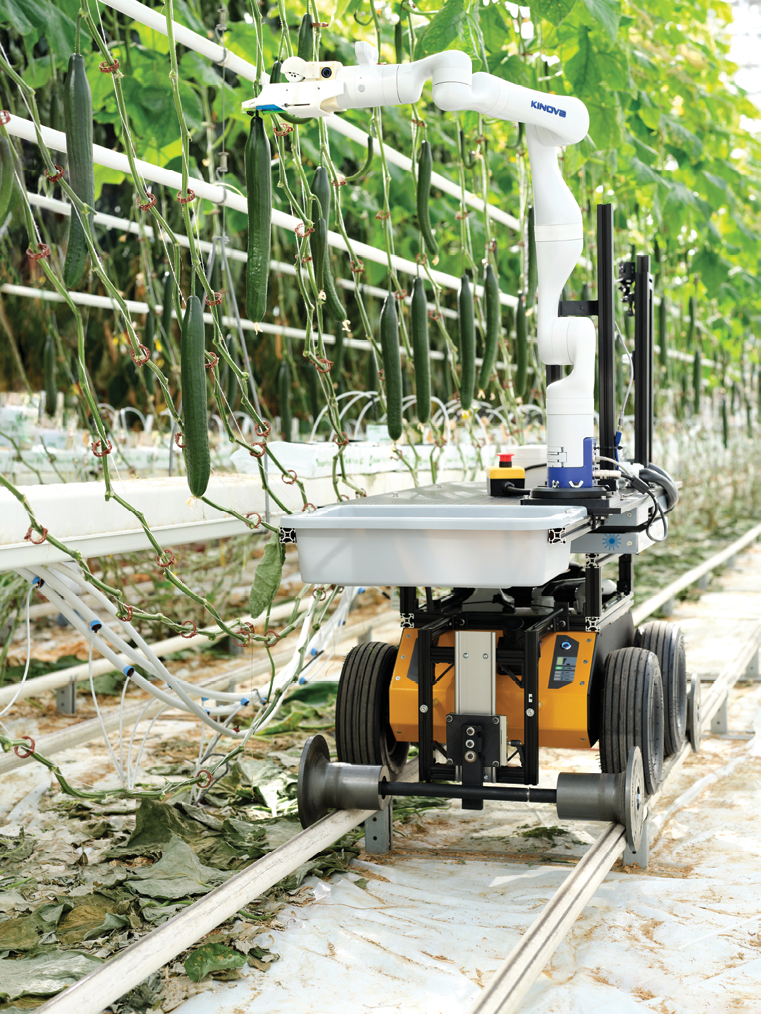

Canadian and U.S. horticulture, like most other sectors in agriculture, is suffering from a growing labor shortage. Overall, an agri-food workforce shortfall is predicted to reach more than 123,000 jobs in Canada by 2029. As such, the search is on for ways to do more with less. At the same time, labor-intensive horticultural crops increase the cost of labor, often representing 40-60% of production costs for growers.
That’s why the industry is increasingly turning to solutions to automate tasks — addressing the labor crunch while also boosting production efficiencies to help growers remain profitable and competitive.
The greenhouse sector, for example, is readily adopting automation for tasks aimed at the management of growing environments, irrigation and fertigation.
A future major threshold is the development of an autonomous greenhouse vegetable harvesting technology, a challenge embraced by Canada’s Vineland Research & Innovation Centre’s automation team. Initially focused on the advancement of a robotic harvesting system for long English cucumbers, this platform technology is evolving to be applied to other crops such as peppers.
Canada is the world’s fourth largest cucumber exporter at over $320 million annually. The potential for growth in the greenhouse vegetable industry is significant, but the cost and restricted availability of workers are holding the sector back. Cucumbers are harvested by hand and Canadian growers spend approximately $27 million annually just on this labor-intensive task.

“We know there are various companies working on autonomous vegetable harvesting solutions around the world, but most indicators for successful deployment are still four to five years away,” says Hussam Haroun, Vineland’s director of automation. “At Vineland, we’ve been able to develop a platform that can be ready earlier.”
Haroun explains that Vineland’s go-to-market timeline is shorter than other companies because they have their own research greenhouse. “One thing that we have that most other places don’t have is that real-life environment testing and system integration,” he says. “We don’t build the robot in the lab with engineers and researchers and then try to find a way to test it in a real environment. We have a research greenhouse, so whenever we’re developing technology, we’re always optimizing it for the efficiency of a real greenhouse environment.”
Vineland’s cucumber harvesting robot is a proof-of-concept solution that moves along rows of plants within the greenhouse. This technology includes a vision system to identify the fruit on the vine, assess ripeness and determine a precise location. It selects the fruit ready for harvest, cuts it from the plant and places it into a harvest bin utilizing a robotic gripper.
Although automation is still somewhat in its infancy in horticulture, automatic systems have long been used in other sectors, including manufacturing and healthcare. It’s a complex field where partnerships are critical to innovation success.
For instance, when it came time to source an arm for Vineland’s cucumber harvesting robot, the team turned to existing technology providers for a solution. The search ultimately led Vineland to Quebec-based Kinova, a robotics company whose specialty lies in biomedical research and assistive devices for humans.
“Kinova was interested in getting involved in the horticulture industry, so that’s very important,” Haroun says. This interest made the company the ideal partner for Vineland’s project.
Their off-the-shelf arm was ideal for adaptation and optimization in a greenhouse environment and the collaboration soon went beyond the initial technology.

“As we began working with Kinova, we realized that their expertise in robotics could also help us improve our technology and make it faster,” says Brian Lynch, Vineland's senior research scientist, field robotics. “Working with partners in allied industries is key to adapting and introducing automation technologies into horticulture.”
“I really believe that we need to look at those other verticals to understand what they’re doing,” Haroun says. Of course, there are differences between the needs of automation in a greenhouse and automation in, say, an automobile factory. “What makes horticulture unique?” Haroun asks. “You’re dealing with plant biology, living things which are quite sensitive.”
Produce-handling technology needs to be gentler than the technology you may see in a factory. Although Haroun describes that difference as a chasm to cross, it’s better to take that already existing technology and adapt it to the needs of horticulture than to start from scratch.
“If you start empty, if you start from the ground up, it can require a lot of new technologies that would be hard to produce,” Haroun explains. “So, we looked at technology already out there that can be customized, so that we’ll be quicker to go to market and it’ll be even more cost-effective.”
Vineland’s close ties to the horticultural industry can help automation and robotics companies in other fields map out opportunities in the sector, with validation testing critical to ensuring grower engagement and buy-in.
Greenhouse production in general is also moving toward a more data-driven, scientific management approach and there are other horticultural crops in need of autonomous solutions. All of this spells an opportunity for innovators, companies and growers, believes Haroun.
“The Vineland approach to innovation, focused on partnerships and collaboration, can help bring these types of solutions to the Canadian industry to address labor shortages and increase the productivity and profitability of the sector,” he says.
This is an important mission for Haroun.
“Greenhouses are becoming more and more mission critical as facilities for food,” he says. “They are so critical to food security and they need that level of automation that we’re looking at. … And that’s why engaging in this kind of collaboration is so critical. No one company can do it alone.”

Explore the March 2023 Issue
Check out more from this issue and find your next story to read.





